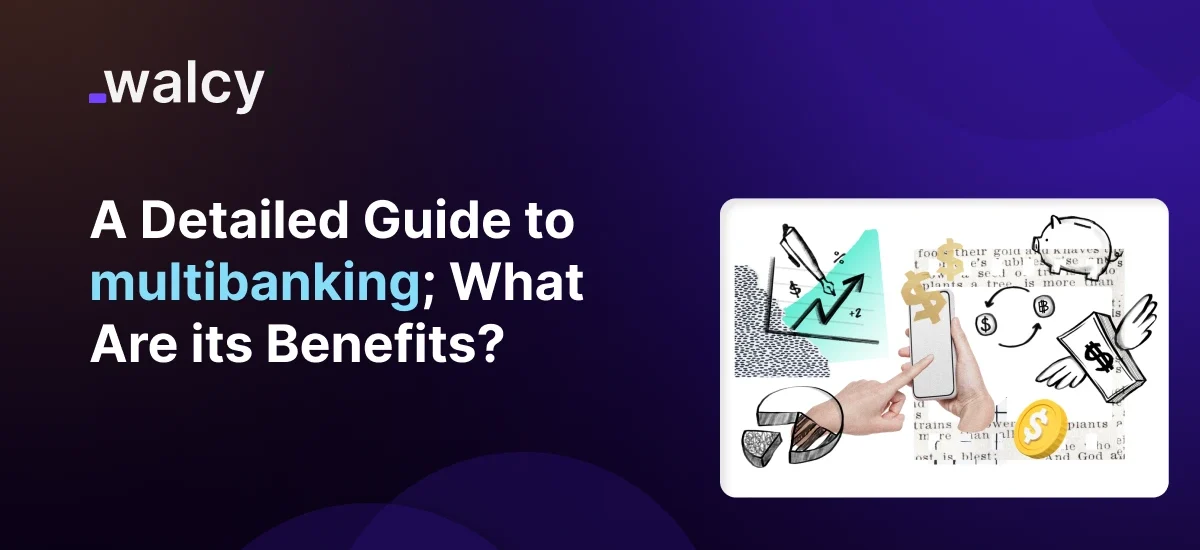In today’s fast-evolving financial world, businesses and people seek new ways of managing their finances more effectively both domestically and internationally. This trend gave birth to a multibanking financial concept that merges multi-banking services, platforms, and currencies into an integrated system. As financial transactions become increasingly complex, the multibanking solution offers flexibility and ease to handle one’s finances with several institutions spread across different geographical regions.
The following guide will explain what multibanking is, its associated advantages, and different types-from multi-currency banks to multinational financial operations-which are described here will be very helpful in many respects to the business and individual in the context of today’s interconnected financial world.
What is Multibanking?
Multibanking is a process in which several banking relationships are maintained and managed via one single platform or system. Multibanking allows users to aggregate accounts, transactions, and financial data from a variety of banks into one easy-to-view location; such an overview of all finances is easier to handle.
High net-worth people, those with sophisticated financial portfolios, and huge corporations with operations across many nations find this technique to be highly productive.
Following are the general standard functionalities of multi-banking platforms:
- Ability to view balance across banks and accounts.
- Cross-channel Payments: Ability to perform cross-channel payments.
- Multi-currency: Handling multi-currency management.
- Access to integrated financial services: access to loans, investments, and transfer access within.
The Key Components of Multibanking
Multibanking encompasses several features in such a way as to help users in handling their financial transactions proficiently. Some key aspects include:
- Multi-Currency Bank Accounts:
With international trade and travel becoming more and more pervasive, people and companies alike have to deal with more than one currency. Multi-currency bank accounts allow users to hold money, receive it, and transfer it in several different currencies without needing to convert that money to their home currency.
This saves on fees that come up with exchanging money. The feature is very useful to MNCs and other businesses that are heavily dealing with international suppliers and clients. Most of these accounts also give hedging opportunities against currency fluctuations; hence, businesses can shield their financial positions from market volatility.
You shall like: 5 Best International Business Accounts | Open From Anywhere
- Cross-channel banking:
The concept of digitalization has dismantled the notion of brick-and-mortar banking. It introduces cross-channel services whereby customers can access their bank on their mobile, online, through the telephone, or physically at a branch outlet. All accounts can be accessed from one interface. This added to convenience and offers smoother transitions between channels.
This way, a customer can also perform various tasks on whatever channel each may prefer. The approach will surely improve the user experience for customers, as it means their financial needs will be served in whatever way.
- Personalized Multibanking Services:
By integrating personalized multi-banking services, financial institutions will be able to provide tailored services for customers. In practical application, personalized multi-banking services could be in the form of customized investment advice, credit options based on transactional history, or curated banking products aligned with the customer’s financial goals.
Personalization is powered by deep analytics, machine learning, and AI-driven tools that process and make sense of oceans of data to arrive at insightful financial counsel.
- Cross-channel banking:
It allows the customer to simply have contact with the bank through different channels, while multichannel banking, combines these into one. This is important for those customers who open accounts in more than one bank. Each channel will be assured of communicating effectively with others.
For instance, a client can view his or her balance using a mobile application, perform money transfers online, and settle bills through an ATM. In this respect, multibanking systems give a real-time update on each kind of operation coming from different channels to provide integrated performance without lapses.
- Multinational Banks and International Multibanking:
Multinational banks and international multi-banking solutions offer services to businesses operating in several countries. These range from global trade finance to foreign exchange management and international cash pooling. On top of classical multi-bank solutions, international multibanking integrates business operations regarding cross-border business into one system.
Large enterprises with subsidiaries spread over various regions may also rely on a multinational bank for more sophisticated banking solutions that can address complex topics such as cross-border tax compliance, regulatory reporting, and intercompany transfers.
- Multi-Functional Banks:
Multi-functional banks provide a broad range of services other than traditional banking, such as management of wealth, insurance coverage, investment services, and business consultancy. These kinds of banks offer their customers one-stop shopping by allowing them access to most financial services in one location.
In a multi-functional bank, users can consolidate services and help make financial management less cumbersome. Other services afford convenience and help reduce the degree to which an individual or enterprise needs to interface with multiple service providers.
Benefits of Multibanking
There are several benefits associated with a multibanking approach for individuals and enterprises. Some of the more recognizable benefits include:
- Centralized Financial Control:
Multibanking provides the customer with a unified view of financial health through one single platform for all accounts that a customer maintains, regardless of the bank. Centralization makes tracking and management of income, expenses, and transactions easier, improving financial control.
- Time and Cost Efficiency:
As multi-banking streamlines a variety of banking services on one platform, it saves time otherwise wasted in managing several bank accounts. This reduction in complexity also contributes to reducing administrative costs, especially for those companies that have several financial accounts.
- Access to a wide range of banking products:
With multibanking, various types of banking products and services can be done from many different institutions. This flexibility allows users to utilize the best interest rates, credit terms, and other financial products presented by different banks without being fully bound to any institution.
- Security:
Security and protection of data head the list of priorities for multi-banking platforms. Advanced encryption and multi-factor authentication keep users’ financial information well-protected. Since cybersecurity is a prime concern in digital banking, multibanking systems invest massively in maintaining a secure environment.
- Informed Financial Decision Making:
Personalized financial services that are integrated into multi-banking platforms enable users to make better financial decisions. With real-time insight into spending habits, investment performance, and account balances, users will be in a better place to make the best use of opportunities that come their way and avoid a few risks.
Disadvantages of Multibanking
Even though multi-banking has several advantages, the following are some challenges that users have to be aware of:
- System Complexity:
Managing several accounts with different banks can be pretty puzzling; on an international scale, this becomes even more so. The users have to ensure that they are oriented within the system of multi-banking and don’t feel confused navigating through their numerous accounts.
- Compliance with Regulations:
One of the most serious challenges that large multinational corporations encounter is maintaining different banking regulations in various countries. Multi-banking systems need to position themselves correctly to handle such complexities, especially regarding AML legislation, tax laws, and financial reporting.
Learn more about: What Are The Penalties For Money Laundering? Quick Facts
- Data Privacy and Security:
Users should ensure that multi-banking has been designed with due consideration for the sensitivity of financial information. In the case of data security breaches, losses could be huge in terms of finance as well as reputation.
- Implementation Cost:
The implementation of a multi-banking system would involve an up-front investment by companies in software, infrastructure, and training. However, the eventual benefits outscore this, so companies need to assess how viable the multibanking solutions are from a financial point of view.
Read about: Top 8 Fintech Trends of 2024 & 2025
Future Trends in Multibanking
In the core, multibanking will be further integrated with state-of-the-art financial management. Here are some of the trends that can shape the future of multibanking as such:
Blockchain and Decentralized Banking:
Blockchain technology may bring a revolution to multibanking by offering it decentralized banking solutions. This will allow faster and safer cross-border transactions than ever before, thus simplifying the handling of various currencies.
AI-Driven Personalization:
In the future, multibanking services will be inextricably linked with artificial intelligence. Moving financial data onto AI-powered platforms provides an excellent opportunity to let this technology make recommendations to users about saving and investing, or making spending decisions optimally.
Open Banking:
Finally, open banking initiatives that will finally allow third-party developers to create an ecosystem of applications and services around financial institutions will enable even greater integration of multibanking services. More variety of banking products and services can be made available on a single platform.
Sustainability and responsible banking:
Sustainability is taking center stage across the globe, and more multi-banking platforms will try to instill responsible banking features. It involves the facilitation of ‘green’ banking products and focuses on investments contributing toward sustainable industries.
Read about: Best Multicurrency Account: What Is It And How It Works?
Conclusion
It’s one of the most important tools for any company or person who desires to use services from more than one financial institution and to support any number of currencies. The multi-banking systems will give one the flexibility that is required to operate in today’s dynamic, globe-spanning economy, with centralized control, increased security, and access to the whole range of banking products.
Though setbacks do exist- issues related to regulatory compliance and system complexity, for example advantages multi-banking has will outweigh all the disadvantages when it comes to smoothing out one’s financial management.
With new advancements in technology, multi-banking solutions will evolve in making their personalization, security, and efficiency in services even better for upcoming generations to come, thus inevitably and irreversibly becoming a necessary part of modern financial management.
Do follow us on Facebook and LinkedIn, to stay connected with us.
Read about: 7 Effective Financial Management Tips For Entrepreneurs



